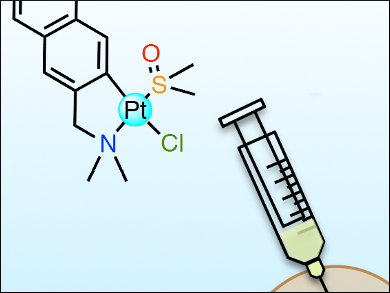Cis-Platinum(II) complexes have been widely investigated for their anticancer activity in an attempt to improve on the success of cisplatin as a chemotherapeutic drug. Many successful examples have been produced, yet the sufficient uptake into cells still remains a problem. Hydrophobicity is one major influencing factor: Coordinating hydrophobic ligands to complexes increases their uptake into cells. However, the influence of aromaticity on drug uptake remains uncertain.
José Ruiz, Universidad de Murica, Spain, and colleagues have investigated the influence of aromaticity on the hydrophobicity and cytotoxicity of chelating organoplatinum complexes (example pictured). The team synthesized C,N-chelating ligands with different biphenyl and polycyclic aromatic moieties and tested the corresponding complexes against various human ovarian, breast, and melanoma cell lines.
The researchers compared accumulation trends using reverse-phase high-performance liquid chromatography (HPLC) and found that accumulation into cells was correlated with hydrophobicity. However, the trend is disrupted for the largest aromatic groups, suggesting that the optimal aromatic moiety for induction of hydrophobicity is a naphthalene group; the half maximal inhibitory concentrations (IC50s) for the different cell lines also confirm this result.
In addition, in vivo studies on fertilized specific-pathogen-free eggs suggest that these compounds also induce antivascular effects (i.e., attack blood vessels feeding a tumor). The biphenyl- and naphthyl-substituted complexes were found to inhibit the formation of blood vessels.
- Exploring the Influence of the Aromaticity on the Anticancer and Antivascular Activities of Organoplatinum(II) Complexes,
Ana Zamora, Sergio A. Pérez, Matthias Rothemund, Venancio Rodríguez, Rainer Schobert, Christoph Janiak, José Ruiz,
Chem. Eur. J. 2017, 23, 5614–5625.
DOI: 10.1002/chem.201700717




